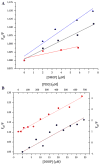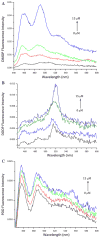Interaction of human serum albumin with novel 3,9-disubstituted perylenes
- PMID: 23975144
- PMCID: PMC3871871
- DOI: 10.1007/s10930-013-9508-z
Interaction of human serum albumin with novel 3,9-disubstituted perylenes
Abstract
Human serum albumin (HSA) has been used as a model for the binding of a number of different ligands, including polyaromatic hydrocarbons, to proteins. In this case we have investigated the interaction of HSA with a novel set of perylene derivatives. Di-substituted perylene analogues have been synthesized as potentially useful organic photovoltaic materials. Their photophysical properties may make them viable for fuel cell applications too. However, these molecules are poorly soluble especially in aqueous solvents. Binding to water-soluble proteins may provide a way to solubilize them. At the same time one can study whether the photophysical processes initiated by the irradiation of a perylene ligand can cause conformational changes to the host protein. With the present study we demonstrated that of the three perylene derivatives investigated only one, the dimethoxy analogue, has a significant affinity for HSA at a binding site near the bottom of the central cleft (in proximity of the Trp214 residue). The small affinity prevents any significant photoinduced changes to occur in the protein.
Figures







Similar articles
-
Interaction of a tyrosine kinase inhibitor, vandetanib with human serum albumin as studied by fluorescence quenching and molecular docking.J Biomol Struct Dyn. 2016 Aug;34(8):1693-704. doi: 10.1080/07391102.2015.1089187. Epub 2016 Jan 27. J Biomol Struct Dyn. 2016. PMID: 26331959
-
Human serum albumin as vehicle for the solubilization of perylene diimides in aqueous solutions.Int J Biol Macromol. 2017 Jan;94(Pt A):246-257. doi: 10.1016/j.ijbiomac.2016.09.109. Epub 2016 Oct 6. Int J Biol Macromol. 2017. PMID: 27720966
-
Investigation of binding mechanism of novel 8-substituted coumarin derivatives with human serum albumin and α-1-glycoprotein.J Biomol Struct Dyn. 2016 Sep;34(9):2023-36. doi: 10.1080/07391102.2015.1104264. Epub 2016 May 4. J Biomol Struct Dyn. 2016. PMID: 26440860
-
The location of the high- and low-affinity bilirubin-binding sites on serum albumin: ligand-competition analysis investigated by circular dichroism.Biophys Chem. 2013 Oct-Nov;180-181:55-65. doi: 10.1016/j.bpc.2013.06.004. Epub 2013 Jun 22. Biophys Chem. 2013. PMID: 23838624
-
Binding of an anticancer drug, axitinib to human serum albumin: Fluorescence quenching and molecular docking study.J Photochem Photobiol B. 2016 Sep;162:386-394. doi: 10.1016/j.jphotobiol.2016.06.049. Epub 2016 Jul 1. J Photochem Photobiol B. 2016. PMID: 27424099
Cited by
-
Biophysical characterization of the interaction of human albumin with an anionic porphyrin.Biochem Biophys Rep. 2016 Jul 18;7:295-302. doi: 10.1016/j.bbrep.2016.07.014. eCollection 2016 Sep. Biochem Biophys Rep. 2016. PMID: 28955918 Free PMC article.
-
Characterization of novel perylene diimides containing aromatic amino acid side chains.Spectrochim Acta A Mol Biomol Spectrosc. 2016 Jan 15;153:124-31. doi: 10.1016/j.saa.2015.08.013. Epub 2015 Aug 16. Spectrochim Acta A Mol Biomol Spectrosc. 2016. PMID: 26298679 Free PMC article.
-
Effects of Visible-Light Irradiation of Protoporphyrin IX on the Self-Assembly of Tubulin Heterodimers.Chemphyschem. 2016 Oct 18;17(20):3269-3282. doi: 10.1002/cphc.201600629. Epub 2016 Aug 30. Chemphyschem. 2016. PMID: 27490308 Free PMC article.
References
Publication types
MeSH terms
Substances
Grants and funding
LinkOut - more resources
Full Text Sources
Other Literature Sources

